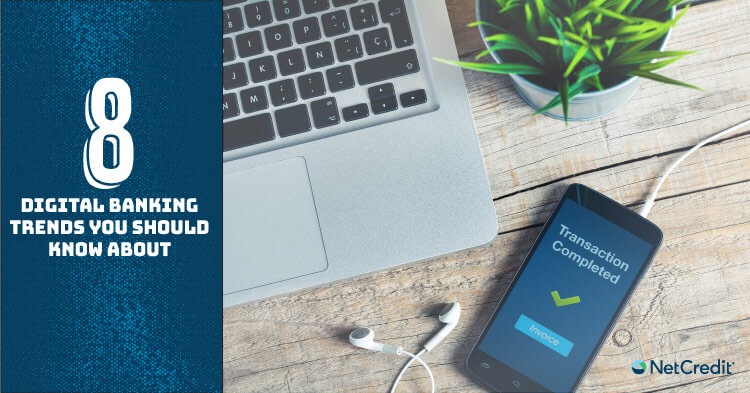Digital transformation is shaping the future of all institutions in our modern world, including financial. As technology advances and individuals place an increasingly growing emphasis on convenience and efficiency over traditional human interaction, customer-based businesses must adapt and grow to meet consumers’ changing needs. The banking industry in particular has seen a dramatic increase in demand for digital transformation and as a result has shifted much of what we traditionally knew as banking to an entirely new model. Here we’re taking a look at trends shaping the next generation of digital banking.
Ease of use
Accessibility to technology has created a culture of immediacy. Consumers today, especially those who grew up with technology, expect clean, easy-to-use experiences. Digital banking apps are the initial response to these expectations, as more banks adopt digital applications to remain relevant and competitive in their market. Fortunately for consumers, this works to our advantage. The more competitive banks become with their technological offerings the better those offerings become. Moving forward, we can expect technology to directly impact how we interact with banks as they work to create more efficient and personalized experiences.
Mobile banking
Our phones accompany us everywhere and for that reason: Their capabilities are all-encompassing. As a result, mobile banking has become the go-to tool for the majority of individuals, particularly in the millennial generation. According to a recent survey of U.S. consumers, 70% feel mobile represents the future of banking and 84% of respondents use mobile banking at least once a week. Today, mobile banking apps allow users to make deposits, complete account transfers, monitor spending and earnings and more, all from one user-friendly platform.
Mobile payment is a rising trend in mobile banking that we can expect to see much more of. This service allows individuals to send or accept payments through their mobile phones. This tool not only improves efficiency and convenience, but it also removes the need for carrying cash, cards and checks. Banks will continue to improve these services allowing for even more mobile banking capabilities and efficiencies.
Mobile wallet
The concept of mobile wallets has been steadily increasing over the past few years and continues to expand into the world of mobile banking. Further reducing the need to carry cash or cards, mobile wallets provide additional convenience by allowing users to make purchases online or in-store simply with their smartphones.
Digital-only banking
The emerging trend of digital-only banks differs from the previously mentioned mobile banking as there are no physical branches accompanying the digital tools. Rather these financial technology firms service customers solely through an internet platform; also known as neobanks. Considering there is no option for physical interaction, digital customer experiences must be exceptional and applications must provide a full range of services and support. Meaning, digital-only banks must be equipped with the technology to securely allow users to create accounts — including submission of all necessary forms, proof of identity and signature verification — as well as all traditional banking services customers require.
While at present, neobanks are still partially in the development stage, their growth and advancement is not far away. Moving forward we can certainly expect to see more from neobanks as digital transformation continues to progress and traditional banks make the shift to meet their customers’ demands.
Tech innovation
As digital banking expands, so does the technology that powers it. Fortunately, with the tools and platforms available today, bankers need not worry about the accessibility, features, or security of their providers.
Artificial intelligence
According to the Business Insider Intelligence report, 48% of banking executives believe new technologies like artificial intelligence (AI) will have the greatest impact on banking through 2020. Currently, AI is being predominantly used in digital banking through the use of chatbots. Institutions such as Bank of America, Wells Fargo and Capital One have been utilizing chatbots for a few years and, as of recently, these AI-powered bots have the capacity to perform banking tasks such as checking account balances and answering questions for highly-personalized experiences. For mobile bankers and individuals on the go, the ability to engage a conversational bot for the same level of service as a human banker provides improved service as bots empower customers for efficient service on the channel they prefer.
Robotic process automation (RPA)
Streamlining service for customers begins with improved back-end processes. RPA in financial services enables financial institutions to automate repetitive tasks and access more in-depth data sources to provide customers with highly personalized experiences. With up to 25% of banking processes projected to be automated within the next few years, automation technology is what will set digital banks up for success against their competitors moving forward. RPA can help to improve the use of data and provide 24/7 service to customers while simultaneously improving the efficiency of internal operations. Fraud detection and protection is also increased through automation implementation, as having humans process sensitive information can often lead to a range of privacy risks. Cognitive RPA bots, on the other hand, can securely process, store and deliver data without error while also tracking and managing data to meet regulatory requirements.
Blockchain
Modern banks have been exploring blockchain technology in efforts to hopefully reap the benefits of cost savings and operational efficiencies it promises to deliver. Across the globe, banks are experimenting with the technology through fintech partnerships and by building their own blockchain solutions. These developments are contributing to banks narrowing their focus on finding tangible use cases for blockchain technology that solve real and current issues faced by their industry. For instance, blockchain could be the solution to transfer efficiency by conducting and confirming transactions and reducing the time required to send money from one party to another. Similarly, it can assist in expediting business and individual loans based on credit history, as blockchain allows borrowers to improve their credit reports’ accuracy, transparency and shareability. Moving forward, we can be certain that blockchain is here to stay as in this age of digital transformation, it is the key solution that allows assets to be truly digitized and secure.
Through technology innovation, many of our traditional processes have changed. Banking is in the heat of digital transformation as processes, protocols and services adjust to changing demands and new capabilities. In the coming years, we can expect these technologies as well as many more to significantly impact our financial industries for the better.






